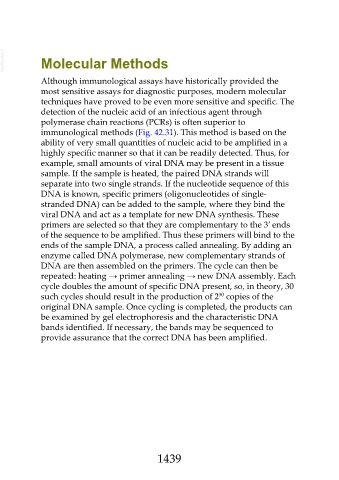Page 1439 - Veterinary Immunology, 10th Edition
P. 1439
VetBooks.ir Molecular Methods
Although immunological assays have historically provided the
most sensitive assays for diagnostic purposes, modern molecular
techniques have proved to be even more sensitive and specific. The
detection of the nucleic acid of an infectious agent through
polymerase chain reactions (PCRs) is often superior to
immunological methods (Fig. 42.31). This method is based on the
ability of very small quantities of nucleic acid to be amplified in a
highly specific manner so that it can be readily detected. Thus, for
example, small amounts of viral DNA may be present in a tissue
sample. If the sample is heated, the paired DNA strands will
separate into two single strands. If the nucleotide sequence of this
DNA is known, specific primers (oligonucleotides of single-
stranded DNA) can be added to the sample, where they bind the
viral DNA and act as a template for new DNA synthesis. These
primers are selected so that they are complementary to the 3′ ends
of the sequence to be amplified. Thus these primers will bind to the
ends of the sample DNA, a process called annealing. By adding an
enzyme called DNA polymerase, new complementary strands of
DNA are then assembled on the primers. The cycle can then be
repeated: heating → primer annealing → new DNA assembly. Each
cycle doubles the amount of specific DNA present, so, in theory, 30
30
such cycles should result in the production of 2 copies of the
original DNA sample. Once cycling is completed, the products can
be examined by gel electrophoresis and the characteristic DNA
bands identified. If necessary, the bands may be sequenced to
provide assurance that the correct DNA has been amplified.
1439

